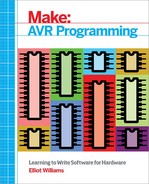Part III. Advanced AVR Topics
Once you’ve mastered the AVR itself, this last section of the book is dedicated to using modern communications protocols to interface with other devices, building the circuitry you need to drive motors and other electrical devices, and covering a few more of the features of the AVR that you may or may not need every day. The projects here are more involved, and you can read these chapters largely in whatever order you’d like. When you’re done with this chapter, you’ll be ready to tackle almost any project that you can dream up that needs a microcontroller.
Chapter 13 covers a software and firmware technique that makes good use of what you’ve learned about PWM. This enables playback of sampled speech, volume control, and mixing of low-fi digital audio signals. You’ll end up with a clean sine wave, a nice-sounding abstract droney noisebox, and an improved, serial-port playable “piano.”
In Chapter 14 and Chapter 15, I’ll show you some simple (and not-so-simple) circuits that you can use to control almost anything that runs on electricity. DC motors, stepper motors, solenoids, and even household appliances can be put under microcontroller control with some additional circuitry. Although the projects in these chapters are basically just about turning motors, I’m hoping that you’ve got an idea why you’d like motors to turn.
In Chapter 16 and Chapter 17, I cover the two most commonly used modern serial peripheral protocols. This opens up the world of sophisticated digital sensors, high-resolution digital-to-analog converters, and external storage. The demos culminate in integrating a 25LC256 external SPI EEPROM and an LM75 I2C temperature sensor into a long-running temperature logger, but similar techniques let you work with anything that speaks either I2C or SPI.
Chapter 18 and Chapter 19 are all about making the most of the AVR’s scarce memory resources, which enables you to do more cool stuff. Thanks to some clever encoding, you can store 10 seconds of sampled low-fi speech data in the read-only flash program memory, enough to make a talking voltmeter that reads out the current voltage to you using your own voice. And though the chip’s onboard EEPROM isn’t all that fast or abundant, it doesn’t disappear when the power goes out and it’s writable from within your code. I show off by making an AVR secret encoder/decoder that stores the passwords in EEPROM. If you have two with the same key phrases stored in them, you can pass encrypted messages.
